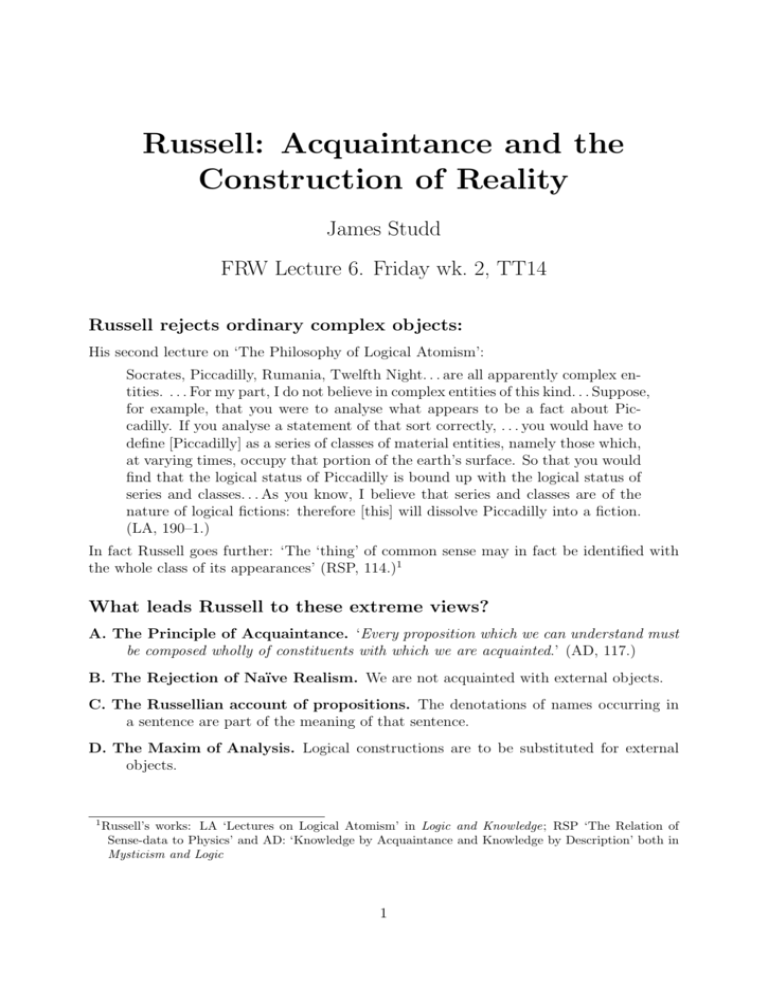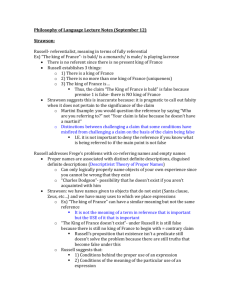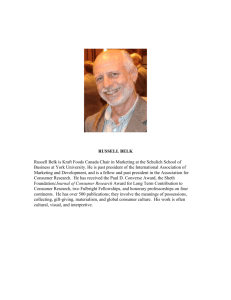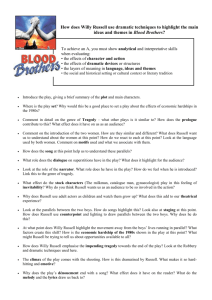Russell: Acquaintance and the Construction of Reality
advertisement

Russell: Acquaintance and the Construction of Reality James Studd FRW Lecture 6. Friday wk. 2, TT14 Russell rejects ordinary complex objects: His second lecture on ‘The Philosophy of Logical Atomism’: Socrates, Piccadilly, Rumania, Twelfth Night. . . are all apparently complex entities. . . . For my part, I do not believe in complex entities of this kind. . . Suppose, for example, that you were to analyse what appears to be a fact about Piccadilly. If you analyse a statement of that sort correctly, . . . you would have to define [Piccadilly] as a series of classes of material entities, namely those which, at varying times, occupy that portion of the earth’s surface. So that you would find that the logical status of Piccadilly is bound up with the logical status of series and classes. . . As you know, I believe that series and classes are of the nature of logical fictions: therefore [this] will dissolve Piccadilly into a fiction. (LA, 190–1.) In fact Russell goes further: ‘The ‘thing’ of common sense may in fact be identified with the whole class of its appearances’ (RSP, 114.)1 What leads Russell to these extreme views? A. The Principle of Acquaintance. ‘Every proposition which we can understand must be composed wholly of constituents with which we are acquainted.’ (AD, 117.) B. The Rejection of Naı̈ve Realism. We are not acquainted with external objects. C. The Russellian account of propositions. The denotations of names occurring in a sentence are part of the meaning of that sentence. D. The Maxim of Analysis. Logical constructions are to be substituted for external objects. 1 Russell’s works: LA ‘Lectures on Logical Atomism’ in Logic and Knowledge; RSP ‘The Relation of Sense-data to Physics’ and AD: ‘Knowledge by Acquaintance and Knowledge by Description’ both in Mysticism and Logic 1 A. The Principle of Acquaintance Acquaintance: a direct cognitive relation Russell: ‘I am acquainted with an object when I have a direct cognitive relation to that object, i.e. when I am directly aware of the object itself.’ (AD, 152.) Examples: what you are acquainted with (a) Your sense data: e.g. your yellow visual-impression of a canary. (b) Yourself (possibly) (c) Universals (or concepts); relations. e.g. being yellow, occurring before Russell: objects not known by acquaintance may be known by description: an object is ‘known by description’ when we know that it is “the so-and-so”, i.e. when we know that there is one object, and no more having a certain property (AD, 156.) e.g. the man in the iron mask is known to us by description, not acquaintance. Useful to distinguish three kinds of knowing A. propositional knowing; knowing that e.g. I know that the inventor of the zip invented the zip (provided one person singlehandedly came up with this innovation). B. knowing who e.g. But I don’t know who invented the zip. Although I do know who invented the light bulb. C. direct-object knowing I don’t know Edison;2 but I do know Clive Sinclair.3 Knowledge by acquaintance is a species of (C): e.g. Bismarck is acquainted with himself. Bismarck knows Bismarck. Knowledge by description is a species of (A): I know Bismarck only by description: e.g. I know that there is exactly one object who was the first Chancellor of the German Empire. 2 3 Inventor of the first commercially viable incandescent light. Inventor of the ZX Spectrum, and Sinclair C5. 2 The principle of acquaintance The fundamental epistemological principle in the analysis of propositions containing descriptions is this: Every proposition which we can understand must be composed wholly of constituents with which we are acquainted. (AD, 159.) ‘The chief reason for supposing the principle true’ ‘it seems scarcely possible to believe that we can make a judgment or entertain a supposition without knowing what it is that we are judging or supposing about’ (ibid.) A simple argument for the principle of acquaintance 1. To understand what a sentence means, we must know the meaning of each of its constituents. 2. So, if a is the meaning of a constituent of a sentence we understand, we must know— i.e. be acquainted with—a (We’ll return to evaluate this argument later.) B. The rejection of Naı̈ve Realism Naı̈ve realism: we (directly) perceive ordinary, external objects: e.g. canaries, not merely canary-sense-data. Russell: we are not acquainted with physical objects (other than sense data and, possibly, ourselves), or other peoples minds. (AD, 155) Problems of Philosophy : an argument against Naı̈ve Realism from perspectival variation Although I believe that the table is ‘really’ of the same colour all over, the parts that reflect the light look much brighter than the other parts, and some parts look white because of reflected light. I know that, if I move, the parts that reflect the light will be different, so that the apparent distribution of colours on the table will change. . . The shape of the table is no better. We are all in the habit of judging as to the ‘real’ shapes of things, . . . But, in fact, as we all have to learn if we try to draw, a given thing looks different in shape from every different point of view. If our table is ‘really’ rectangular, it will look, from almost all points of view, as if it had two acute angles and two obtuse angles. . . . Thus it becomes evident that the real table, if there is one, is not the same as what we immediately experience by sight (The Problems of Philosophy, 10-11.) Consequently, what we do immediately experience—sense data—is distinct from the table. 3 C. The Russellian account of sentence meaning Frege vs. Russell on sentence meaning Russell on sentence-meaning Consider (1) Mont Blanc is high Russell (assuming ‘Mont Blanc’ to be a proper name): the fact expressed by (1) has the object denoted by ‘Mont Blanc’ and the quality expressed by ‘is high’ as constituents. Frege on sentence-meaning Frege rejoins in a letter to Russell: ‘Mont Blanc with its snowfields is not itself a component part of the thought that Mont Blanc is more than 4,000 metres high.’4 Instead, recall that Frege distinguishes between sense and reference: • the reference of (1) is simply its truth value (lacking constituents). • the thought expressed by (1), has the sense of the name ‘Mont Blanc’ and the sense of the predicate ‘is high’ as constituents, not their references. Russell replies Concerning sense and reference, I see nothing but difficulties which I cannot overcome ... I believe that in spite of all its snowfields Mont Blanc itself is a component part of what is actually asserted in ‘Mont Blanc is more than 4,000 metres high’. We do not assert the thought, for this is a private psychological matter: we assert the object of the thought, and this is, to my mind, a certain complex (an objective proposition, one might say) in which Mont Blanc is itself a component part. If we do not admit this, then we get the conclusion that we know nothing at all about Mont Blanc.5 Recap: the principles so far lead us to a negative conclusion (A) Principle of Acquaintance: if we understand the proposition (1) expresses, we must be acquainted with all of its constituents. (B) Rejection of Naı̈ve Realism: we are not acquainted with external objects like Mont Blanc (but merely with Mont-Blanc-sense-data). (C) Russellian account of meaning : if ‘Mont Blanc’ has Mont Blanc as its meaning, Mont Blanc occur as a constituent in the proposition expressed by (1). So: Either we don’t understand (1) or ‘Mont Blanc’ does not stand for an external object. Russell opts for the second disjunct. 4 Letter to Russell, dated 13 November 1904 in Frege: Philosophical and Mathematical Correspondence, ed. Gabriel (University of Chicago Press, 1980) 5 Letter to Russell, dated 12 December 1904, ibid. 4 D. The maxim of analysis Logically proper names ‘Mont Blanc’ isn’t really a proper name. Russell: Proper names are ‘words which do not assign a property to an object, but merely and solely name it.’ (AD, 162.) Examples of logically proper names ‘there are only two words which are strictly proper names of particulars, namely, ‘I’ and ‘this’. (ibid.) Russell later retracts ‘I’: only demonstratives directly naming sense-data function logically as proper names. Other apparent proper names are disguised descriptions Russell uses the example of Caesar (though it would be equally true of Mont Blanc): I assume that it will be admitted that [Caesar] himself is not a constituent of any judgment I can make. . . in order to discover what is actually in mind when I judge about Julius Caesar, we must substitute for the proper names a description made up of some of the things I know about him. . . Suppose our description is ‘the man whose name was Julius Caesar ’. Let our judgment be ‘Julius Caesar was assassinated.’ Then it becomes ‘the man whose name was Julius Caesar was assassinated.’ Here Julius Caesar is a noise or shape with which we are acquainted. Thus our judgment is wholly reduced to constituents with which we are acquainted. (AD, 160–1.) ‘On Denoting’: broadly logical reasons to treat names as descriptions: e.g. negative existentials, etc. (see also AD, 162ff.) Russell now has an epistemological reason: the Principle of Acquaintance: we cannot understand the proposition (2) expresses if ‘Julius Caesar’ names Caesar: (2) Julius Caesar was assassinated. (3) Dxpx is named J. Caesar ^@ypy is named J. Caesar Ñ x “ yq^x was assassinatedq Russell: when analysed as (3), Caesar does not occur as a constituent and we are acquainted with the universals it contains. Worry: do we have acquaintance with, e.g. the universal assassinated Unlike e.g. yellow we have not been acquainted with assassinated sense data. 5 Russell’s construction of the physical world Russell takes the analysis of external objects rather further in RSP: ‘The supreme maxim in scientific philosophising’: ‘Wherever possible, logical constructions are to substitute for inferred entities.’ (RSP, 115.) Mathematics: numbers are logical constructions: e.g. NumpF q “ tX : X « F u Physics: objects are logical constructions The ‘thing’ of common sense may in fact be identified with the whole class of its appearances—where, however, we must include among appearances not only those which are actual sense-data, but also those ‘sensibilia’, . . . which on grounds of continuity and resemblance, are to be regarded as belonging to the same system of appearances, although there happen to be no observers to whom they are data. (RSP, ) Roughly: the penny I perceive = td : d relevantly resembles my penny datumu ‘Sensibilia’: ‘objects which have the same metaphysical and physical status as sense-data without necessarily being data to any mind.’ Objection: the penny is located in front of me; the class of sensibilia is not Reply: Russell analyses ‘location’, in terms of ‘perspective’-space Perspectives: spaces of sense data belonging to a single observer (or spaces of sensibilia belonging to a single possible observer). (RSP, 117–8) e.g. in my perspective the penny-datum is located in front of the student-data. Perspective space (Russell’s replacement for physical space): its points are perspectives. Locating objects in space (I) Order points in perspective-space via a reference object. Suppose, say, that a certain penny appears in a number of different perspectives; . . . in some it looks circular, in others it presents the appearance of an ellipse . . . We may collect together all those perspectives in which the appearance of the penny is circular. These we will place on one straight line [for later use: l] ordering them in a series by the variations in the apparent size of the penny. Those perspectives in which the penny appears as straight line of a certain thickness will similarly be placed upon a plane [P ] ordered as before by the apparent size of the penny. (RSP, 118–9) (II) Locate objects in (perspective-)space by exploiting the geometrical relations between the points at which the object appears. e.g. The penny is located where l intersects P . (Compare RSP, 120) Refinements: time, persistent things (RSP, 123ff.) 6 Selected Objections Is the Principle of Acquaintance self-evident? Recall our ‘simple argument’: 1. To understand what a sentence means, we must know the meaning of each of its constituents. 2. So, if a is the meaning of a constituent of a sentence we understand, we must know— i.e. be acquainted with—a. Fallacy: knowing what the meaning is conflated with (direct-object) knowing the meaning. e.g. to understand ‘Socrates is mortal’ I need to know what ‘Socrates’ means; I don’t need to know Socrates. How can Russell’s theory of meaning account for singular thought? How can the truth of (4) and (5) be reconciled with Russell’s theory? (4) George IV wondered whether Scott wrote Waverley (5) Scott is such that George IV wondered whether he wrote Waverley By The Principle of Acquaintance, George IV must be acquainted with the constituents of the proposition he wonders about. Russell: in (4): ‘Scott’ is replaced with a suitable description: (R-4) George IV wondered whether D!xppSpxq ^ W pxqq Hintikka: this won’t work for (5):6 (R-5) D!xppSpxq ^ George IV wondered whether W pxqq To make Spxq true, x must be assigned to Scott; but then George IV isn’t acquainted with a constituent of the proposition expressed by W pxq (with x so assigned). Sense data theory: veil of perception? In learning about Russell’s constructed world of sets of sensibilia, why think we learn anything about the real world? How are we to distinguish veridical data from dream data? 6 ‘Knowledge by acquaintance–individuation by acquaintance’ in Pears (ed.) Bertrand Russell: A Collection of Critical Essays. 7






